
Tour 3 : Southern Guernsey
A fine old manor house, historic museums and enticing bays with sparkling water make up this 26-mile (42km) day tour of southern Guernsey
Highlights
To explore southern Guernsey, leave St Peter Port along the South Esplanade, passing Castle Cornet, then bear right to follow the main road uphill. The road twists up a delightful wooded valley to emerge on the grassy common that fronts the entrance to Fort George, the massive garrison that was built to protect St Peter Port at the turn of the 18th century. Turn left to follow Fort Road, and you will pass the Fermain Valley Hotel en route to the delightful Fermain Bay.
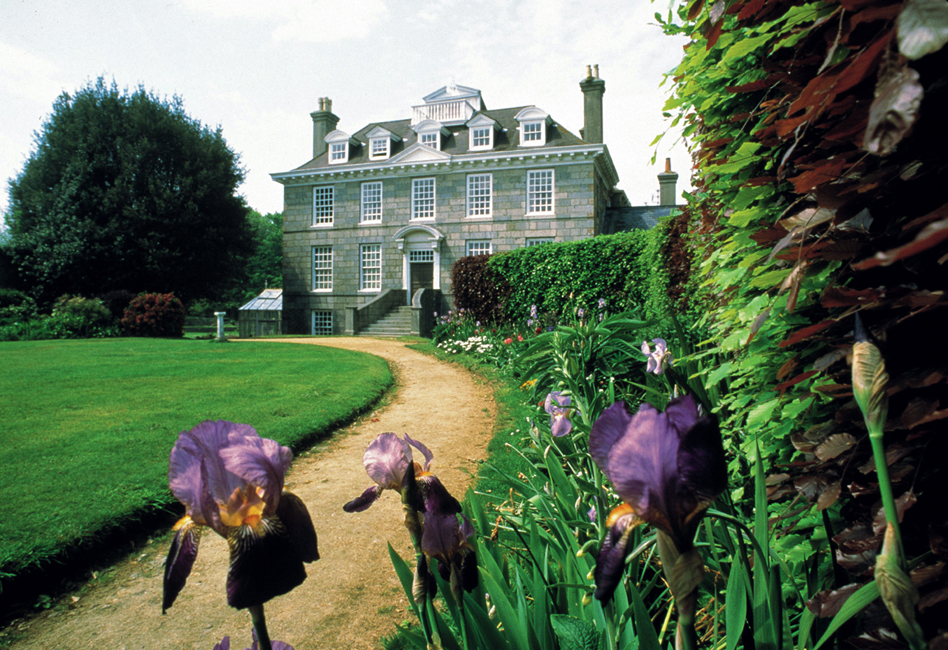
Sausmarez Manor.
Visit Guernsey
SAUSMAREZ MANOR
A little further along the main road, surrounded by gardens, lies Sausmarez Manor 1 [map] (daily 10am–5pm, www.sausmarezmanor.co.uk, grounds free apart from Artparks). Take a tour of the house (June–Sept Mon–Thur 10.30am, 11.30am and 2.30pm, first half Apr and second half of Oct Mon–Thur 11am, late Apr, May and first half of Oct Mon–Thur 10.30am and 11.30am; charge) and you will discover that this is the stronghold of one of Guernsey’s oldest families: the de Sausmarez family have lived here since 1254, and a fine series of family portraits hangs in the imposing grey granite house, which dates from 1714. The family has been one of Guernsey’s most distinguished dynasties for centuries, having served as bailiffs, governors, naval officers and diplomats. The refreshing lack of austerity is due to the fact that the manor is still lived-in. You may well come across the seigneur, Peter de Sausmarez, chatting to visitors. He also takes the Ghost Tours on Thursday evenings.
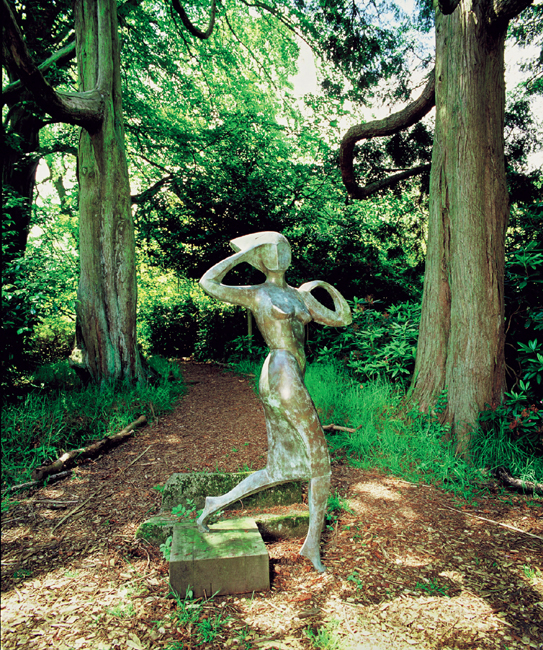
The Sausmarez sculpture park offers a great variety of works.
Visit Guernsey
Only a fragment of the ancient building, in the form of an outhouse containing stonework, dates from the mid-13th century. Since then the manor house has been added to many times. Its most distinguishing feature is the Queen Anne facade, which was erected between 1714 and 1718, and replaced an earlier Tudor building. It was a refusal on the part of Sir Havilland de Sausmarez to modernise that saved much of this heritage from the Nazis. In 1940 the Germans were intending to use Sausmarez Manor as a hospital but decided not to go ahead with their plans because the house did not yet have electric lighting.
MANOR GARDENS
Delightfully informal gardens surround the house, where you might possibly trip over free-range ducks and hens scrabbling for food in the undergrowth as you explore the lake and extensive woodlands. Unusually, overall admission is free, you just pay for the individual attractions. These include a nine-hole testing pitch-and-putt course (Apr–Dec daily 10am–5pm; equipment free with a deposit); the Coppersmiths’ Workshop in the Tudor Barn where the craftsman is the only surviving coppersmith to make the Guernsey milk cans, used for centuries; ride-on 7¼-gauge trains for children’s rides in the garden; a gift shop and a tearoom in the old vinery by the lakeside; and Le Petit Monde outlet with local products, souvenirs and ethically sourced home furnishings. Whether you’re into art or not, don’t miss ArtParks, one of the largest and most varied sculpture parks in Britain, set amid subtropical woodland. Showing around 220 works by 90 artists, this is a fascinating collection, from life-size figures to flying frogs, with a surprise round every corner. All of the exhibits are for sale, and have their prices alongside – but deep pockets are definitely required.
Guernsey Gâche
Guernsey gâche (pronounced ‘gosh’) is one of the tastiest sweets of the Channel Islands, and consists of flour, butter, eggs, candied peel, sultanas, milk and sugar. Guernsey gâche in Jersey tastes different from Guernsey gâche in Guernsey. This is because each island jealously protects the purity of its own distinctive breed of cattle, which means that the milk of each island tastes slightly different.
If you happen to be at Sausmarez Manor on a Saturday you’re in for a treat. The Farmers’ Market is held in the grounds from 9am–12.45pm and has a wonderful range of local produce: chancre and spider crabs, local beef and pork, free-range eggs, cheeses, Guernsey gâche and home-made cakes and pies. You will also find handmade arts and crafts, bric-a-brac, jewellery, antiques and plants.
From Sausmarez Manor turn right onto the main road, then straight on following the signs for Moulin Huet Bay. A left turn at the Bella Luce Hotel will take you down a pretty green lane from where there is a pleasant walk down to Moulin Huet Bay 2 [map] with its sea caves and a waterfall. The bay is best enjoyed when the water is at half-tide or below, as the loveliest bits are covered by water at high tide. This is gorgeous landscape that inspired the paintings of Pierre-August Renoir.
LA GRAN’MÈRE DE CHIMQUIÈRE
Return to the main road, which brings you to St Martin’s Village, with a cluster of shops and banks. It is worth finding a parking space in the centre and walking up the lane that leads northwards to visit St Martin’s parish church and pay your respects to the Gran’mère de Chimquière 3 [map] . This Grandma is considerably older than most and, though stony faced, she nevertheless flaunts her naked breasts. She is, in fact, a 4,500-year-old goddess carved in granite, standing at the entrance to St Martin’s churchyard and, if you visit after a wedding, she is quite likely to be wearing a garland of flowers: newlyweds traditionally place flowers on her head for luck. Grandma was carved at two separate stages: around 2,500BC the block of granite was erected here, dressed and smoothed to create a female figure with breasts, folded arms and a girdle. During late Roman times, around AD200 or 300, the facial features were recarved, and Grandma was given a set of curls and a short buttoned cape falling around her upper torso. The crack through the torso is believed to have been from an attack by a church warden who was angry about the worshipping of stone idols.
From St Martin’s, follow signs to the airport along Guernsey’s south coast road. To the left, after a mile or so, some of the island’s most attractive water lanes run down to Petit Bôt Bay 4 [map] , a small but popular bathing spot, especially when the tide is out, and one of the island’s sunniest and most sheltered bays. To reach it by car turn left after the Deer Hound Inn. A Napoleonic-era tower stands guard over the bay, and what was once an old mill is now occupied by a tearoom. It is here that the best-known water lanes are to be found. The brooks that run down the sides of these lush green lanes used to power two mills, one of which was used for paper-making. The few remaining water lanes give a feel of how Guernsey used to be before the Occupation, when German forces surfaced over most of the streams.

Gran’mère de Chimquière is an ancient pagan goddess.
Visit Guernsey

Bathers enjoy the warmth of the sun at Petit Bôt Bay.
Mockford and Bonetti/Apa Publications
GERMAN OCCUPATION MUSEUM
The next left turn off the main road leads to Forest Church, thought to have been built on the site of a dolmen, and then to the German Occupation Museum 5 [map] (daily 10am–5pm, last admission 4pm; charge) which lies behind the church. This is an excellent war museum whose owner sells the tickets and makes the home-made cakes served in a pretty tea garden. Interesting and unusual items are displayed amongst the general mass of weapons, ration books, uniforms and medals. At the entrance are wartime photographs taken by German soldiers, in which they are cooking rabbit stew in a cauldron. A large painting depicts a Rhine Valley scene, complete with castle and vineyards, painted on the walls of a nearby house by a homesick soldier. Another rarity is a stone painted with a red V (for Victory) sign. Guernsey people showed their defiance by painting such signs wherever they could until the occupying troops took to painting laurel wreaths underneath to represent German victory.
There are some wartime condoms (German issue), a doll’s house made from cardboard boxes, and letters from the Controlling Committee of the States of Guernsey giving instructions for the distribution of food during the dark days towards the end of the war when food was desperately short. Surprisingly, cigarettes did not need to be rationed – experiments in growing tobacco on Guernsey proved very successful, ensuring an unlimited supply of locally made cigarettes.
Haunted House
At Pleinmont Point, on the dramatic headland, a watchtower and an ex-military post is known as ‘Victor Hugo’s haunted house’, having been immortalised by the writer in his novel of 1866, Les Travailleurs de la Mer (The Toilers of the Sea) which is set in Guernsey. The building was last used during World War I as a signalling station, but was then destroyed by the Germans in World War II, and today it lies in a state of ruin.
The museum’s reconstruction of a wartime kitchen on Guernsey brings home just how little the islanders, and the occupying troops, had to live on, once the Allied landings in Normandy had cut off vital supply lines from the Continent. Surviving on a diet of bramble-leaf tea, acorn coffee, marrow pudding and potato bread, the only variety in the diet came from the occasional jelly made from carrageen moss (a type of seaweed) served with sugar beet syrup. There is also a reconstruction of a Guernsey street, with shops and people, as it looked in 1940, and there are videos explaining the various types of German fortifications to be seen around the island.

The German Occupation Museum holds the finest collection of wartime effects in the Channel Islands.
Visit Guernsey

The Table des Pions, linked with fairies, witches and elves in local folklore.
Mockford and Bonetti/Apa Publications
PLEINMONT PENINSULA
To see one of the most striking of these German fortifications, return to the main road and turn left at the junction. After about 3 miles (5km) you will pass Torteval Church on the right, with its distinctive round tower and witch’s-hat spire. In a mile (1½ km) turn left, and head for the restored Pleinmont Observation Tower 6 [map] (Apr–Oct Wed–Sun 2–5pm, last admission 4.30pm; charge) with a car park nearby. A prominent feature on this windy headland, this is a five-storey concrete tower, pierced by viewing slots. It was from here that German observers controlled Guernsey’s coastal artillery, communicating with the gunners by radio.
On the same headland to the north is the Table des Pions 7 [map] also known as ‘The Fairy Ring’, a grassy mound encircled by a ditch. This spot played a prominent role in a medieval ceremony, the Chevauchée de St Michel, when officers of the feudal court inspected the highways and sea defences to ensure that local landowners were fulfilling their duty to maintain them. The pions were the footmen who accompanied the officers and the Table des Pions was the spot where they took a break to enjoy an open-air banquet. The Chevauchée (briefly revived in 1995) was banned in 1837 because the pions, following what they claimed as an ancient right to kiss any women whose path they crossed, made free with the governor’s wife.

A Celtic cross at Torteval Church memorialises war casualties.
Mockford and Bonetti/Apa Publications
Returning up Guernsey’s western coast, there is a sheltered sandy beach at Portelet Harbour, lying at the foot of the dramatic south coast cliffs. This quiet cove with a small working harbour is a good spot for a swim if the tide is out. Beyond is a pretty wooded valley, owned by the National Trust of Guernsey.
ROCQUAINE BAY
Rocquaine Bay merges with L’Erée Bay, at low tide, to form one continuous stretch of sand – Guernsey’s biggest beach, with safe swimming and rock pools to explore. In late July the beach is the main focus of the Rocquaine Regatta, a full (and free) day and evening of entertainment and whacky events like raft racing.
Guernsey on Foot
In the second week of June keen hikers join the 40-mile Itex charity walk (www.itexwalk.gg) around the coast of Guernsey. Participants can expect to complete the course in anything between 11–14 hours. Those who prefer shorter strolls can pick up a free walking map from the Guernsey Information Centre with details of coastal and inland walks plus all the attractions en route. Guernsey and its sister islands boast a rich variety of habitats for wildlife and birdlife; RSPB walks and events are organised throughout the year (www.rspbguernsey.co.uk).
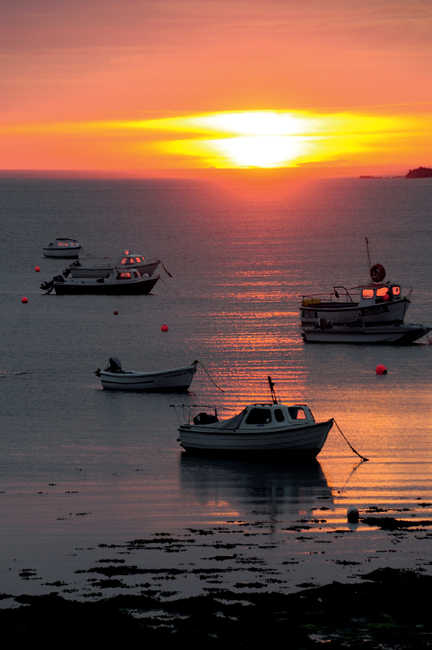
Rocquaine Bay has a long sandy beach at low tide.
Mockford and Bonetti/Apa Publications
Fort Grey
At the southern end of the bay you will find Fort Grey 8 [map] (Apr–Oct daily 10am–5pm; charge), named after the governor of the day, and built in 1804 as part of Sir John Doyle’s grand scheme for defending Guernsey against potential attack from Napoleon’s army. With its outer curtain wall and inner tower, the fort is aptly known as the Cup and Saucer. Today the tower is home to Guernsey’s excellent Shipwreck Museum. The island’s western shores, including the notorious Hanois reef, have seen numerous vessels come to grief. The sea surrounding Guernsey was for a long time the cornerstone of two important sea routes: the transatlantic run to the United States and the southerly run from Britain and northern Europe to the Mediterranean. Most disasters occurred in the peak shipping years of the 19th century. Building a lighthouse on the Hanois reef in 1862 reduced the annual toll of shipwrecks, and in 1975 the shipping lane for ocean-going vessels was moved 10 miles (16km) west to avoid further casualties. The lower level of the museum features a whole range of finds from a ship’s bell salvaged from the sea to cutlery and a fine candelabra, and coffee pots from SS Yorouba, which foundered in 1888.
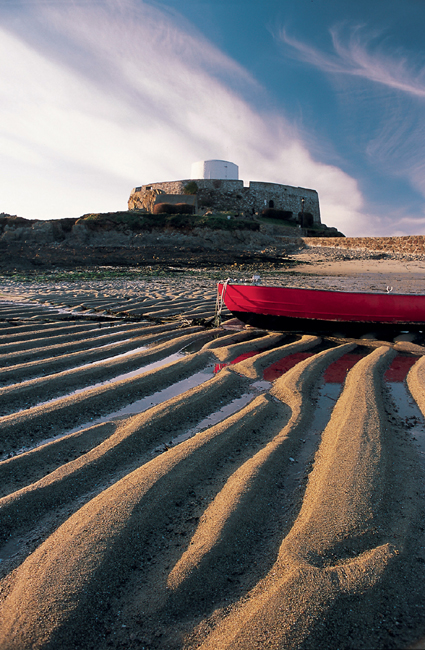
Fort Grey is known to locals as the ‘Cup and Saucer’, due to its shape.
Visit Guernsey
During summer months the History in Action Company puts on performances at the fort in which the Militiaman recounts tales of derring-do.
If you’re in need of refreshment cross the road to Guernsey Pearl 9 [map] (Mar–Oct daily 9.30am–5pm) which has a café serving an excellent crab salad and cream teas, with a sea-view terrace. Rather than being locally sourced, the pearls nearly all originate from the Far East, but are made up here; you can watch the art of pearl stringing in the workshop and purchase jewellery from the large showroom.
A GUERNSEY TO WEAR
Next door you can find items handmade by local craftsmen and artists, and Guernsey sweaters can be purchased from Le Tricoteur. While the word ‘jersey’ has entered the English language, the stylish Guernsey is far less well known, and the Alderney is a garment whose existence is known only to a few connoisseurs and knitwear historians (except in Australia, where the term is used for football shirts). The Guernsey sweater was originally made for seamen, the tightly knitted stitches producing a hard-wearing garment. By the 19th century the Guernsey had become well known and Nelson adopted it as standard issue for the English navy.
SILBE NATURE RESERVE
Return to St Peter Port by taking the road inland, just north of Guernsey Pearl. Bird-lovers should seek out the Silbe Nature Reserve in the Rue du Quanteraine, just to the north of the main road. Though it consists of little more than a group of fields watered by a stream in the Quanteraine Valley, it attracts plenty of birds, and is a pleasant spot for a stroll.
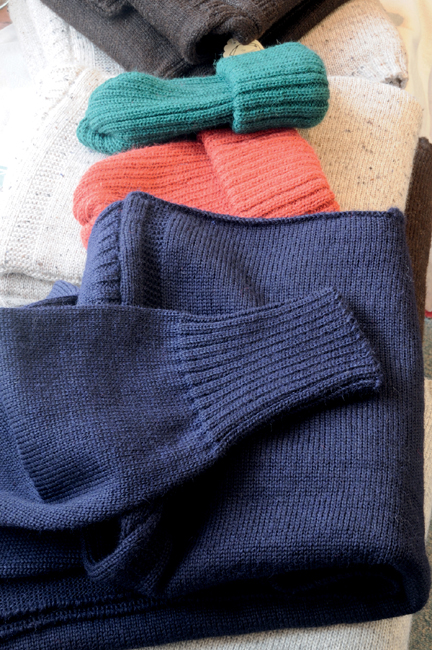
The hard twist given to the dense wool fibres make the Guernsey sweater (originally made for fishermen) resistant to seaspray.
Mockford and Bonetti/Apa Publications
The main road brings you to St Peter’s Parish Church, which sits on the side of a valley. A church has stood here since 1030, though the building you see today dates from the 14th and 15th centuries.
To return to St Peter Port take a right turn shortly after the church, which will take you past the airport, and back into town.
Eating Out
La Barbarie Hotel
Saint’s Road, St Martin; tel: 01481-235 217; www.labarbariehotel.com; lunch and dinner.
Traditional bar food or an exotic seafood platter can be enjoyed by the pool of this old, country hotel. Four-course set dinners change daily. ££
Bella Luce Hotel
La Fosse, St Martin’s; tel: 01481-238 764; www.bellalucehotel.com; lunch and dinner.
This is a stylish hotel in the peaceful green lanes of St Martin’s, where you can come for light bar meals, a leisurely Sunday lunch or gourmet three-course dinners. Cuisine is contemporary and can be enjoyed either in the bar or the colonial-style dining room, which opens out onto a lovely walled garden for summer meals. ££
Café l’Escalier
Le Gouffre, Forest, tel: 01481-264 121; www.lescalierguernsey.co.uk; daily 9am–late.
Lovely clifftop café/restaurant serving breakfast, lunch, cream teas and casual evening meals. A perfect spot for clifftop walkers in need of a respite. Paella is served outside on the seaview terrace on Sundays in summer. £–££
Deer Hound Inn
Le Bourg, Forest; tel: 01481-238 585; Mon–Sat 11am–late, Sun noon–late.
Good for pub grub and choice of beer and ales. Sunny terrace for meals alfresco, and Wi-fi. £
Water’s Edge
Imperial Hotel, Pleinmont, Torteval; tel: 01481-264 044; lunch and dinner.
Sea views towards Fort Grey are the big attraction here. You can come any time for bar meals, traditional cream teas or home-made cakes and coffee in the gardens. The à la carte menu features lobster and other seafood from the bay. £–£££